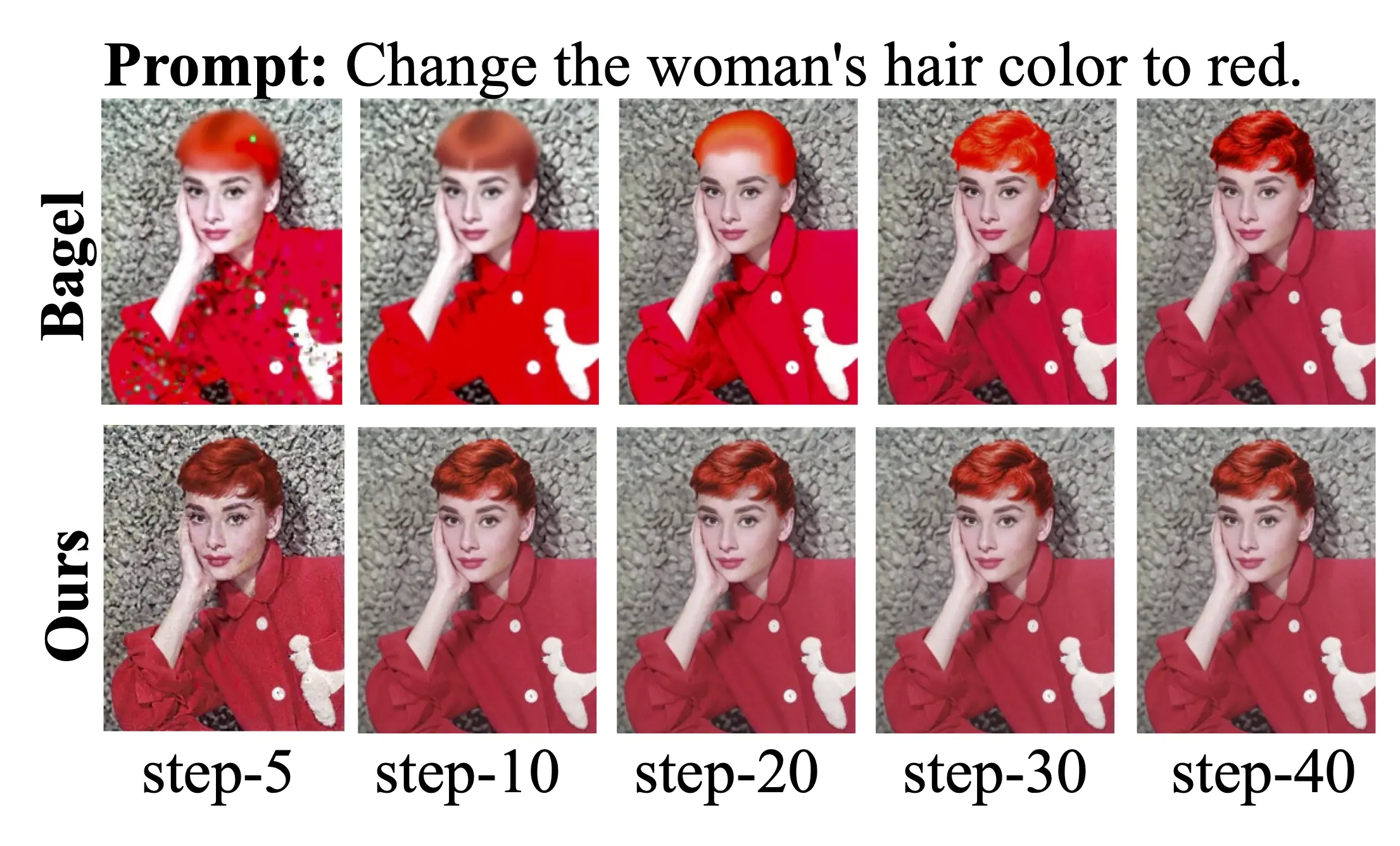Fast-BAGEL (LGCC): Fast and Detail-Enhanced Image Editing

LGCC: Fast and Detail-Enhanced Image Editing (Fast-BAGEL)
Official implementation of our paper: "LGCC: Enhancing Flow Matching Based Text-Guided Image Editing with Local Gaussian Coupling and Context Consistency"
LGCC (publicly released as Fast-BAGEL) is a novel framework that addresses key limitations in flow matching-based image editing models like BAGEL. Existing methods often suffer from detail degradation, content inconsistency, and slow inference speeds. Our framework introduces two core innovations—Local Gaussian Noise Coupling (LGNC) and Content Consistency Loss (CCL)—to deliver faster, more detailed, and context-aware image edits.
Key Contributions
- 🚀 Drastic Inference Speed-Up: Achieves a 2x speedup for universal editing and a 3x–5x speedup for lightweight edits, requiring only 40%–50% of the inference time of BAGEL or Flux.
- ✨ Superior Detail Preservation (LGNC): Improves local detail scores on I2EBench by 1.60% by preserving fine-grained spatial information during the editing process.
- 🧠 Enhanced Content Consistency (CCL): A novel loss function that ensures semantic alignment between the text prompt and the image, preventing unintended removal or alteration of background content.
- 🧩 Efficient Finetuning: Successfully integrated with the powerful pre-trained BAGEL model via curriculum learning, demonstrating a highly effective and data-efficient training strategy.
Performance Benchmarks
LGCC significantly outperforms existing baselines in both quality and efficiency.

Fig. 1: LGCC (Fast-BAGEL) achieves superior or comparable quality in just 20-25 steps, while the original BAGEL requires 50 steps.
The LGCC Framework
Our framework introduces two key components to enhance the flow-matching pipeline:
1. Local-Gaussian Noise Coupling (LGNC)
To combat detail degradation, LGNC abandons random noise initialization. Instead, it models the target image embeddings and their locally perturbed counterparts as coupled pairs. This preserves essential spatial details from the source image throughout the diffusion trajectory.
# LGNC: Aligning noise with local latent characteristics to preserve detail sigma = 0.9 # Coupling strength epsilon = torch.randn_like(packed_latent_clean)Align the noise with the local latent distribution
align_epsilon = epsilon * latent_std + latent_mean
Couple the aligned noise with the clean latent for a detail-aware trajectory
coupled_noise = packed_latent_clean + sigma * align_epsilon
2. Content Consistency Loss (CCL)
CCL is a novel loss function designed to prevent content "hallucination" or unintended alterations. It enforces semantic alignment between the editing instructions and the final image, ensuring that only the specified regions are modified while the rest of the image content remains consistent.
Getting Started
Running Inference
Download the model from our Hugging Face repository and run the inference script. 50 steps are recommended for high-quality results.
# Example: Run inference with 20, 40, and 50 steps
CUDA_VISIBLE_DEVICES=0 python inference_ds.py \
--model_dir /path/to/models/fast-bagel \
--num_timesteps=20,40,50 \
--time_shift=4Citation
If you find our work useful for your research, please cite our paper:
@article{liu2025-fast-bagel,
title = {LGCC: Enhancing Flow Matching Based Text-Guided Image Editing with Local Gaussian Coupling and Context Consistency},
author = {Fangbing Liu and Pengfei Duan and Wen Li and Yi He},
journal = {arXiv preprint arXiv:2511.01894},
year = {2025}
}Loading QR code...





